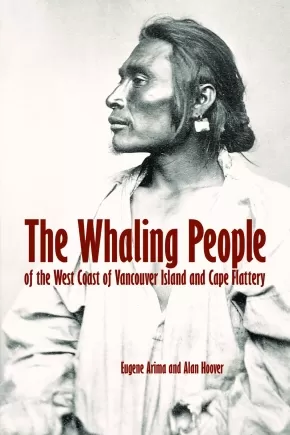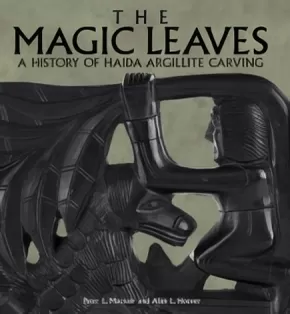
Alan L. Hoover
Alan L. Hoover worked in the RBCM's anthropology collections for 33 years and retired in 2003, as manager of the department.
Books (2)
Making a Chaputs: The Teachings and Responsibilities of a Canoe Maker
$24.95
Format:
Paperback
Text Content Territories:
Indigenous Canadian; First Nations; Nuu-chah-nulth (Nootka); Tla-o-qui-aht First Nation;
Reading Level: N/A
ISBN / Barcode: 9780772680273
Synopsis:
Synopsis:
A rich visual testament to the practical and cultural power of the dugout canoe, balanced in its description of meaning and method.
Tla-o-qui-aht master canoe maker Joe Martin, in collaboration with former museum curator Alan Hoover, describes the meaning and method behind one of the most vivid and memorable symbols of the Northwest Coast: the dugout canoe. Both artform and technological marvel, the chaputs carries Indigenous cultural knowledge passed down through generations, not only of the practical forestry and woodworking that shape every canoe, but also of the role and responsibilities of the canoe maker.
The text includes both a step-by-step explanation of the canoe-making process from tree selection onward (carefully described and dynamically illustrated) and the personal histories of a number of Joe's canoes, encompassing their planning, creation, cultural significance and role in the process of reconciliation. The teachings Joe received from his father and the expertise he has gained in a lifetime of canoe-making are recorded here in his own words for generations to come.
Reviews
“In Making a Chaputs, Nuu-chah-nulth canoe artist Joe Martin shows how he carves dugout canoes, explaining how and why he makes two full-size canoes from a single cedar log. It is a clever, amazing tradition rooted in deep respect for the forest and a lifetime of Indigenous knowledge—a highly recommended book!”—Kathryn Bernick, archaeologist and author of numerous books including Waterlogged: Examples and Procedures for Northwest Coast Archaeologists and Basketry and Cordage from Hesquiat Harbour
“When tracing ancient basketry styles in the archaeological waterlogged/wet sites of the Salish Sea for thousands of years, we defined our approach as Generationally-Linked Archaeology. As seen at the Makah Ozette Village archaeological wet site from ca. 1700, preserved chaputs canoe models reflect this West Coast tradition a full 16 generations back. Joe Martin, Tla-o-qui-aht First Nation Elder and master canoe carver, best reflects these generationally linked traditions, constructing over 60 full-size chaputs, passing this paramount art on through Native apprentices and, here, in his own words, with esteemed curator and author Alan Hoover.” —Ed Carriere, Suquamish Elder and Master Basketmaker and Coast Salish Canoe Carver, and Dale R. Croes, Ph.D. Northwest Coast wet site archaeologist, Washington State University, co-authors of Re-Awakening Ancient Salish Sea Basketry
Additional Information
96 pages | 8.97" x 8.97" | Paperback
The Whaling People of the West Coast of Vancouver Island and Cape Flattery
$19.95
Artists:
Format:
Paperback
Text Content Territories:
Indigenous Canadian; First Nations;
ISBN / Barcode: 9780772664914
Synopsis:
Synopsis:
The Whaling People live along the west coast of Vancouver Island and Cape Flattery in Washington. They comprise more than 20 First Nations, including the Nuu-chah-nulth (formerly called Nootka), Ditidaht, Pacheedaht and Makah. These socially related people enjoyed a highly organized, tradition-based culture for centuries before Europeans arrived. As whaling societies, they had a unique relationship with the sea.
In The Whaling People, Eugene Arima and Alan Hoover give an intimate account of the traditional ways in which these coastal people looked at and understood the world they lived in. They present the activities, technologies, and rituals that the Whaling People used to make a living in their complex coastal environments, and their beliefs about the natural and supernatural forces that affected their lives. The book features 12 narratives collected from First Nations elders, each illustrated with original drawings by the celebrated Hesquiaht artist Tim Paul.
This informative and entertaining book celebrates the still-thriving cultures of the Whaling People, who survived the devastating effects of colonial power and influences. It includes a history of treaty-making in BC, leading up to the just-ratified Maa-nulth Treaty signed by five First Nations of the Whaling People.
Additional Information
272 pages | 6.00" x 9.00"
Authenticity Note: Because of the artwork and narratives contributed to this work from First Nations elders and Hesquiaht artist Tim Paul, it has received the Authentic Text and Artwork labels. It's up to readers to determine if this work qualifies as authentic for their purposes.
Teen Books (1)
The Magic Leaves: A History of Haida Argillite Carving
$39.95
Format:
Paperback
Text Content Territories:
Indigenous Canadian; First Nations; Haida;
ISBN / Barcode: 9780772647733
Synopsis:
Synopsis:
Peter Macnair and Alan Hoover recount the history of Haida argillite carving since it began in the early 1800s, and they describe more than 200 examples from the extensive collection of the Royal BC Museum
Argillite is a dense, black shale mined from a quarry on Haida Gwaii (Queen Charlotte Islands), reserved for the exclusive use of Haida carvers. Argillite works are unique in style and character, ranging from ceremonial pipes and model poles to elaborate platters and chests.









